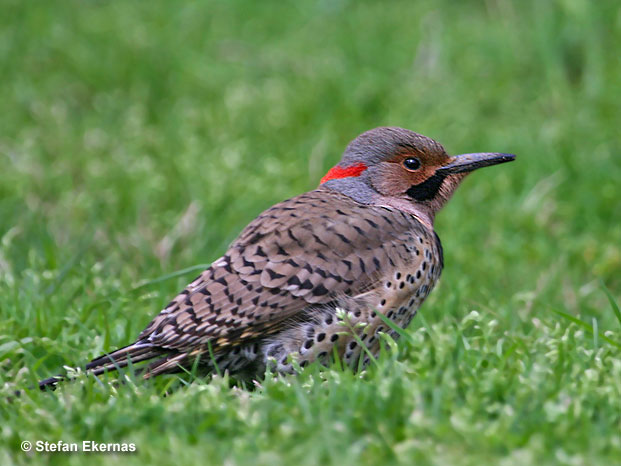The Northern Flicker is a large woodpecker with gentle expressions and black-scalloped plumage. They have long, flared tails that taper off, rounded heads, and slightly curved bills.
When on a walk, you may find that you spook one up to the trees from the ground. The ground is not where you’d expect a woodpecker to be, but Northern Flickers mostly consume beetles and ants. They’ll dig for them with their slightly curved bills. When they fly, you can see a flash of color in the wings. The color changes depending on the region you’re in. The flash of color is yellow in the East and red in the West.
The Northern Flicker usually inhabits forest edges and open woods. However, don’t scan the trees; scan the ground! Additionally, listen for their piercing yelp and loud, ringing call. In the later summer months, listen for incessant yammering. This sound comes from hungry nestlings and will help you find a nest.
On this page
Breeding Male
Northern Flickers are brown overall and have a white patch on their rump that is visible in flight and when perched. The tail feathers and undersides of the wings are bright yellow for birds that live in the east or red for birds that live in the west.
On closer inspection, you’ll see that their brown plumage is patterned with black bars, crescents, and spots. This bird is often referred to as the bird with red spot on the back of its head, which technically is true for most woodpecker species. The red spot is great for telling the difference between male and female Northern Flickers.
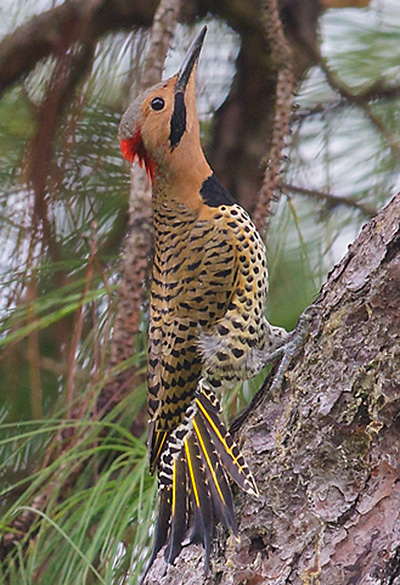
Photograph © Glenn Bartley.
These birds are 11.0 to 12.2 inches (28 to 31 centimeters) long and weigh 3.9 to 5.6 ounces (110 to 160 grams). They’re about half the size of a Hairy Woodpecker.
Female
Female Northern Flickers look very similar to breeding male Northern Flickers. However, females in the East lack the black mustache that males have. Females in the West lack the red mustache that their male counterparts males have.
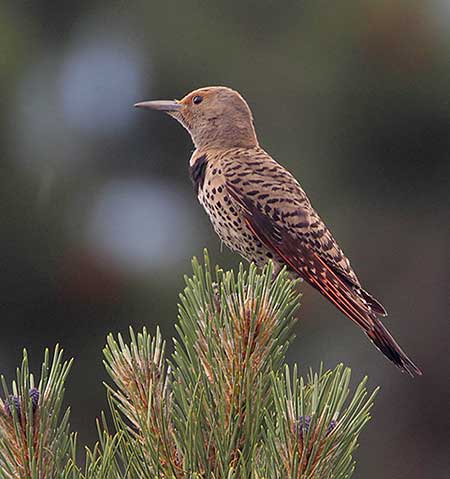
They’re brown overall and have a white patch on their rump that is visible in flight and when perched. The tail feathers and undersides of the wings are bright yellow for birds that live in the east or red for birds that live in the west.
Related: Types of Woodpeckers in North America
On closer inspection, you’ll see that their brown plumage is patterned with black bars, crescents, and spots. They’re the same size and length and are the same weight.
Juvenile
Juvenile male Northern Flickers (red- and yellow-shafted) have a pale orange mustache that will change to the classic red or black mustache that adults sport. Females look the same but don’t have the pale mustache.
It takes 14 days for Northern Flickers to hatch. After that, they’ll remain in the nest for 24 to 27 days and will be cared for by both parents. After fledging, the Juveniles will continue to be fed by both parents but quickly learn how to find food independently.
North America has two subspecies of Northern Flickers that are easy to identify. The yellow-shafted birds, including the Great Plains and Texas, are from the East. The red-shafted birds are from the West.
The critical difference between these two subspecies is the color of the flight-feather shafts, which are either a rosy red or a lemon yellow.
Habitat
Northern Flickers prefer to inhabit open habitats near trees. This includes edges, woodlands, parks, and yards. In the West, Red-shafted Northern Flickers are in mountain forests all the way up to the tree line.
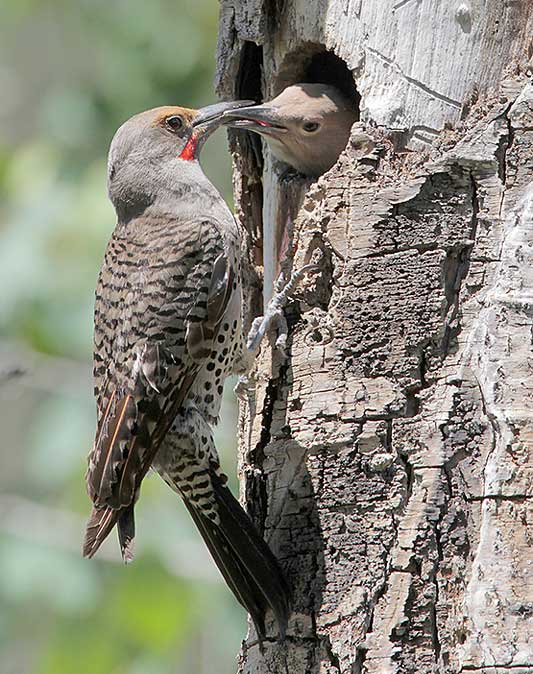
Diet
Northern Flicker’s diet primarily consists of insects. They prefer beetles and ants, which they can gather from the ground. They’ll also consume seeds and fruits, especially in the winter months. These birds often go after ants underground because this is where the larvae live; larvae are very nutritious for them.
Related: Why do woodpeckers peck wood?
Northern Flickers hammer at the soil like other woodpecker species drill into wood. They’ll even break into cow patties to eat insects inside of them. Northern Flickers have tongues that can dart out 2 inches beyond their bill to capture prey.
Other invertebrates they’ll consume are butterflies, flies, snails, and moths. The berries and seeds they’ll consume include poison ivy, poison oak, dogwood, wild cherry, sumac, wild grape, bayberries, elderberries, hackberries, sunflower seeds, and thistle seeds.
Behavior
Northern Flickers aren’t your typical woodpecker. They mostly forage on the ground, sometimes with blackbirds and sparrows.
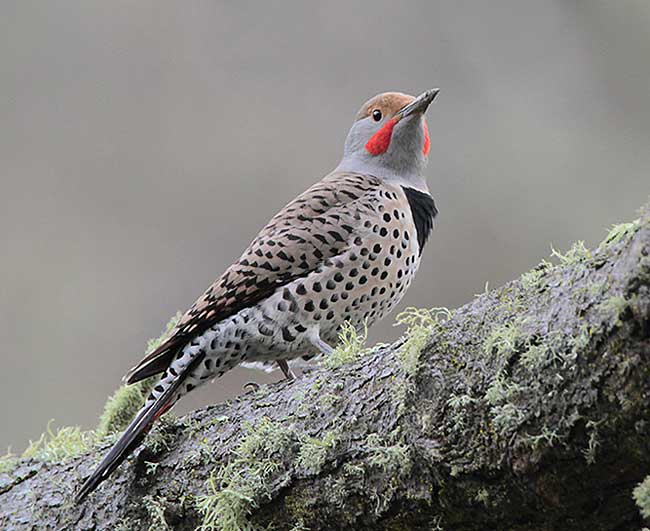
When spooked, Northern Flickers will fly to trees and perch themselves on a horizontal branch rather than the tree trunk. However, they do fly like most woodpeckers.
They rise and fall in a smooth motion and have periods of flapping with gliding. In the early spring and summer, rival birds may face off in a “fencing duel” while a potential mate looks on. This display involves two birds that face each other on a branch. They point their bills upward and bob their heads while drawing a loop or figure-eight pattern in the air.
Range (and seasonal changes)
Northern Flickers are short-distance migrants or year-round residents. These birds will leave the northern parts of their range before winter and head to the southern portions of the U.S. Northern Flickers that breed farther south usually stay put for the winter.
Wing shape
Both Northern Flicker subspecies have broad wings with rounded tips. Their wings are tan and have a wingspan of 16.5 to 20.1 inches (42 to 51 centimeters).
Fun Facts
- Northern Flickers symbolize healing, music, creativity, strength, adaptability, good luck, and new beginnings. They represent strength and determination for most people, making them popular spirit animals.
- Northern flickers are one of many birds that participate in wanting. Anting involves birds rubbing insects, usually ants, into their feathers and skin. Ants have an acid that they secrete that helps the birds get rid of parasites.
- These birds are one of the few strongly migratory woodpeckers. Birds in the northern parts of their range move to the southern portions of North America for the winter.
- Northern Flickers are labeled as the “anteaters of the sky.” This is because they eat more ants than any other bird in North America. One scientist found that a Northern Flicker has more than 2,000 species of ants in its stomach!
- Northern Flicker is the state bird of Alabama.
Vocalization
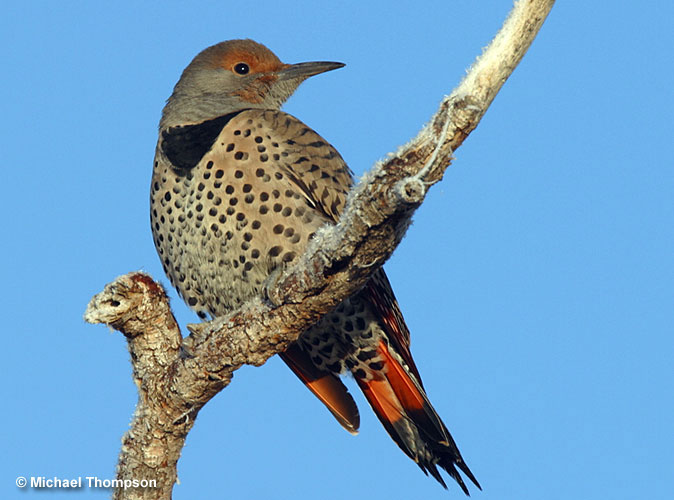
Northern Flickers make a rolling rattle that’s quite loud. Their tone is piercing and will rise and fall in volume. The song lasts 7 or 8 seconds and sounds very similar to the Pileated Woodpecker.
You’ll most commonly hear these calls in the spring and early summer. This is because this is when pairs are forming and territories are being established. Additionally, Northern Flickers make a single-note call that is also very loud and sounds like kyeer.
Both male and female Northern Flickers make an evenly spaced, loud, rapid drumming sound by hammering against metal objects and trees.
If you observe these birds drumming, you’ll most likely see them pause, move their head slightly, and begin drumming again. Usually, when they move, a very different sound is made.
Similar Species
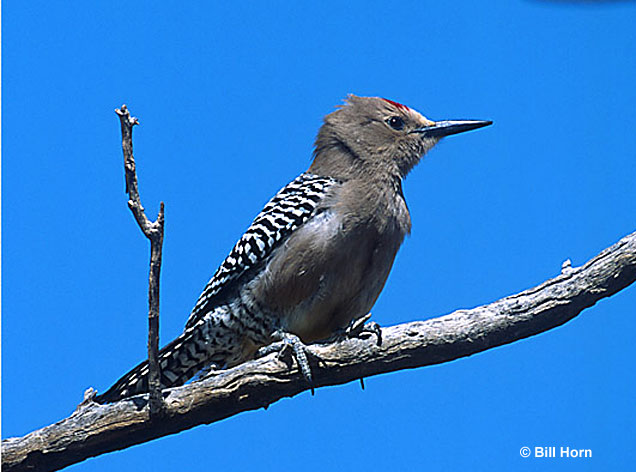
Gila Woodpecker
Compared to Northern Flickers, Gila Woodpeckers have a more laid-back plumage. Northern Flickers have a more speckled look, whereas Gila Woodpeckers have a simple brownish chest and belly.
Their backs and wings look a bit different too – Northern Flickers have a beige-black pattern, while Gila Woodpeckers have more white and black.
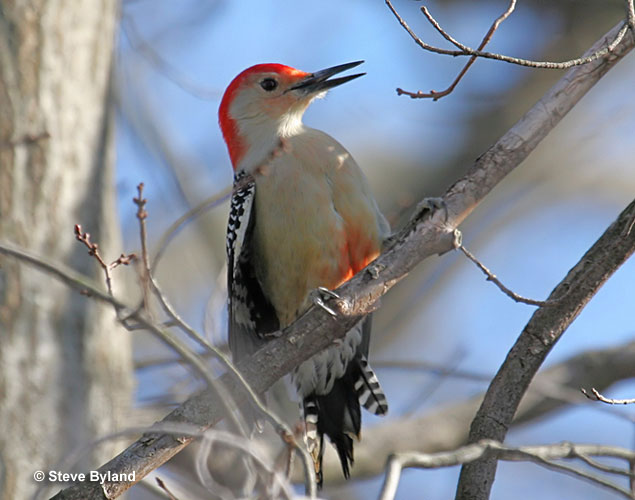
Red-bellied Woodpecker
As the name suggests, Red-bellied Woodpeckers have a small patch of red on their bellies, but more importantly, both males and females have a long red stripe on the top of their heads.
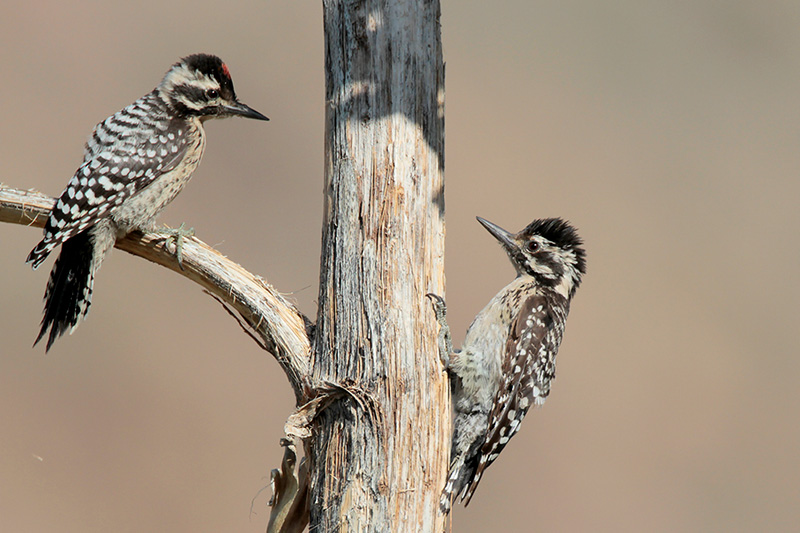
Ladder-backed Woodpecker
Although Ladder-backed Woodpeckers look similar in some senses, they still look strikingly different.
Ladder-backed Woodpeckers have black stripes on their heads and are quite a bit smaller than Northern Flickers.
Frequently Asked Questions
Are Northern Flickers rare?
Northern Flickers are not rare. They’re a widespread, common bird with a breeding population of 12 million.
Why is a Northern Flicker not called a woodpecker?
The Northern Flicker got its name comes from the tail linings, bright wing color, and rump patch. They “flicker” when in flight. It’s not called a woodpecker because they don’t behave as most woodpeckers do.
What does a Northern Flicker sound like?
Most often, Northern Flickers make a single-note call that is also very loud and sounds like kyeer.

